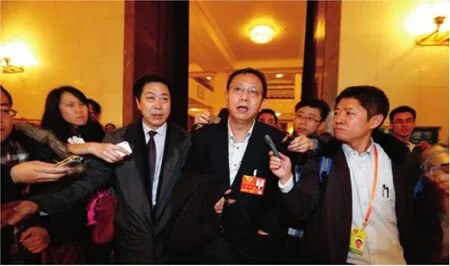A Needed Reform Interest rates must be fully liberalized to meet the demands of the market
2013-03-05ByJiaKangandMengYan
By Jia Kang and Meng Yan
A Needed Reform Interest rates must be fully liberalized to meet the demands of the market
By Jia Kang and Meng Yan
In recent years, interest rate liberalization has been widely discussed amidst China’s financial reforms. The People’s Bank of China (PBC) expanded the floating range of deposit and loan interest rates in 2012, and eliminated the floor on lending rates on July 20, 2013, a clear indication of the government’s intention to liberalize interest rates in future financial reforms.
Exploring the potential impact on China’s currency and adjusting financial asset structures during interest rate liberalization is of prime importance. Activating existing assets doesn’t mean merely speeding up the circulation of monetary credit, but restructuring monetary credit and pushing forward the transformation of China’s economic growth pattern.
Imbalanced allocation
Why is the interest rate liberalization so vital to China’s financial reforms? For years, China has adopted a policy of “financial repression.” Since deposit and loan interest rates were artificially depressed, they failed to reflect the real status of money supply and demand. Under such circumstances, the demand for bank credit funds has far exceeded supply, and a lack of transparency has led to an imbalance in the allocation of credit.
As banks account for a large part of social financial assets, the bond market has been dispirited. As of May 2013, loans issued by financial institutions had reached 67 trillion yuan ($10.95 trillion), while the total assets of commercial banks had surpassed 139 trillion yuan ($22.71 trillion), according to PBC statistics.
In contrast, the total assets of China’s insurance industry were a mere 7.7 trillion yuan ($1.26 trillion), and deposits in the bond market were 25 trillion yuan ($4.08 trillion), the total value of the stock market at 24.7 trillion yuan ($4.04 trillion). Counting in the 8 trillion yuan ($1.31 trillion) of trust products, the size of the non-bank financial markets is equivalent to the balance of commercial bank credit. However, the 8 trillion yuan of trust products mostly came from commercial bank loans, and the 10 trillion yuan ($1.63 trillion) bank financial products should also be categorized as bank credit.
Apparently, bank credit comprises the lion’s share of China’s social financing, behind which is the government’s regulation of the bond and stock markets, as well as the suppression of interest rates. Since interest rates are kept low, it’s much easier for enterprises to get loans than issuing bonds or financing by getting listed on the stock market. In other words, companies are not compelled to raise money in these ways, resulting in the comparative lag in bond and stock markets.
The control of deposit and loan rates, though effectively protecting commercial banks, should be blamed for the structural imbalance of bank credit assets. When the supply of social funds falls short of the demand, a polarization also takes place in the allocation of commercial bank credit.
On the one hand, financial institutions tend to lend money to three groups—credible large state-owned enterprises (SOEs), local governments and well-known private enterprises. On the other hand, cash-strapped small and medium-sized enterprises have found it tough to get credit. They can only seek loans from informal financial institutions.
As of June 2013, small and micro-sized enterprises received 12.25 trillion yuan ($2 trillion) in loans from financial institutions, accounting for 28.5 percent of the total loans granted to enterprises. Even so, regulators like the PBC and China Banking Regulatory Commission have repeatedly required financial institutions to strengthen financial support to small enterprises and projects related to agriculture and the needs of farmers and rural areas.
At the same time, in order to avoid supervision, commercial banks have injected trillions of yuan into government projects and real estate companies in the form of bank financing and securities asset management, forcing the structural mismatch of bank credit funds to deteriorate.
A vital step
With “repressed” interest rates, commercial banks inevitably fall into a laggard operating and management state. Before the change in July, China had imposed both an upper limit on deposit rates and a lower limit on loan rates, which secured a stable and profitable interest margin for commercial banks.
As long as commercial banks run in an organized way and have basic credit risk prevention measures in place, they will generate stable revenue and won’t bother innovating and becoming competitive.

WHAT’S THE WORD: Jia Kang, Director of the Research Institute of Fiscal Science, Ministry of Finance, is surrounded by journalists after attending the First Session of the 12th CPPCC National Committee meeting on March 3
Easy access to bank loans makes SOEs inefficient. In addition to management factors, low-cost loans are a major culprit behind their inefficiency. As many SOEs struggle with assetliability ratios of more than 50 percent, interest payments account for a large share of their operating cost. As interest rates are lower than the cost of social funds, SOEs are not pushed to improve management and reduce overhead costs. In this sense, they lag far behind private or small and micro-sized businesses, which can only resort to high-cost private lending.
Low bank rates also undermine the growth of wealth. Large amounts of household deposits have hitherto been a major source of profits for commercial banks. To cope with economic volatility and uncertainty, Chinese residents, who are not used to taking risks, tend to deposit their savings in low interest bank accounts.
Therefore, it seems to be the inevitable choice to liberalize interest rates, which becomes an important link in China’s financial system reform.
Liberalizing interest rates will give an impetus to China’s capital market. The pricing system of social capital will be restructured, bank interest rates will return to market levels, and the bond and stock market will become more attractive to fund raisers.
In addition, the assets of commercial banks will also shrink. Fluctuating interest rates may generate negative interest margins, and then commercial banks will try to handle the swelling credit assets through operations like asset securitization, which will simultaneously expand the bond market. In short, commercial bank assets will witness a decline in the financial system.
Interest rate liberalization will reshuffle the credit structure of commercial banks. Large and competitive enterprises will be better positioned to win favor from investors in the capital market, and commercial banks will find it more difficult to absorb high-quality customers. In this way, they will take a fancy to small and mediumsized enterprises and more willingly lend them money.
Progressing steadily
China has been liberalizing interest rates gradually. While the floor on lending rates has been fully removed (although limits do remain on mortgages to help cool the housing market), the ceiling on deposits remains.
Now, China’s interest rate reform has entered a new phase. Other support measures should be put in place to prevent the national economy and financial system from serious potential risks.
In the 20th century, an array of countries carried forward interest rate liberalization in a very cautious way. For instance, in the 1980s, the U.S. interest rate reform lasted six years. Including the incubation period, it took 15 years for the country to liberalize interest rates.
Why is China so cautious about removing the upper limit on deposit rates?
First, if the upper limit is suspended, the price of social funds will promptly shoot up, which may deal a heavy blow to the financial system and normal operations of the economy, just like what happened to many economies during their periods of interest rate reforms.
Second, the government needs to make some preparations before calling off the upper limit, such as establishing a deposit insurance system and formulating laws regarding possible bankruptcies of financial institutions. By thoroughly unleashing deposit and loan rates, competition among commercial banks will intensify and there will be some losers in the end. Even when the United States underwent the interest rate liberalization, swaths of small and medium-sized banks went bust.
Hence, before interest rates are further liberalized, more steps are needed to establish a financial safety net.
External changes are needed to succeed, including adjusting the way local governments spend money, improving the operating and management of commercial banks and optimizing the capital market.
China will need to dampen the enthusiasm of local governments to spend on grandiose projects for the sake of generating high GDP growth. Commercial banks should also take steps to brace themselves for future interest rate risks. At the same time, the capital market should be upgraded to allow more room for the bond and stock markets to provide financial services.
Generally speaking, it will take a long time before China fully liberalizes interest rates. By learning from other countries and gradually loosening the deposit rate ceiling, China will finally achieve this goal.coastal city
Fully liberalizing interest rates will have the greatest impact on China’s financial system and economic and social life.
Jia Kang is Director of the Research Institute of Fiscal Science under the Ministry of Finance; Meng Yan is an associate researcher at the
Research Institute of Fiscal Science.
yushujun@bjreview.com
杂志排行
Beijing Review的其它文章
- promoting Trade Foreign trade can play a bigger role in ensuring stable economic growth
- Mind Your Own e-Business! More job hunters start business careers on the Internet
- Seeking a Cure Cities are upgrading drainage systems to battle chronic flooding
- ABANDON SHIp ? NOT SO FAST China is set to revitalize its beleaguered shipbuilding sector?
- Trying a New Way Beijing NGO launches a charity program to encourage carpooling
- Who Wants to Be Number Two?Imagining a future beyond the superpower paradigm
